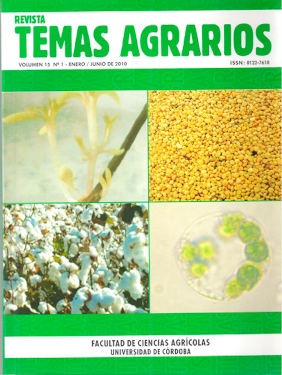Gastropods associated with Eichhornia crassipes in the wetlands complex of the bajo Sinu (Cordoba, Colombia)
Gastrópodos asociados a Eichhornia crassipes en el complejo cenagoso del bajo Sinú (Córdoba, Colombia)

This work is licensed under a Creative Commons Attribution-NonCommercial 4.0 International License.
Show authors biography
Between September 2004 and January 2005, the characterization of gastropods related with Eichhornia crassipes roots was carried out in the Purísima swamp and San Vicente spout, located in the Bajo Sinú wetland complex in Córdoba Department, Colombia. In each sector was located a station from which a sample with three replicates for five months of sampling was taken out. For the collection a network of 150 microns mesh eye, connected to a frame of 625 cm2 was used. Representatives of eight species of gastropods were collected in the swamp of Purísima, and seven in the spout of San Vicente. Assessments based on species density and using classification analysis, we determined that the composition of gastropod populations behaved similarly during the study period in both sectors. Physicochemical variables recorded in the two fields of study showed a similar trend, so during the rainy season and high water levels were low dissolved oxygen, total hardness and calcium, while in the dry season and low water levels predominated means of oxygen and high total hardness and calcium, indicating that differences in communities are those of the sector, caused by the system environmental characteristics, and the influence of man.
Article visits 962 | PDF visits
Downloads
- APHA AWWA WPCF. 1985. Standard Methods Examination of Water and Wastewater, 16 Ed. Washington, E.U.A.
- AMBIOTEC Ltda. 1997. Diagnostico Ambiental del la Ciénaga Grande de Lorica y Ciénaga de Betancí. URRA S.A. Santa fé de Bogotá D.C. 425p.
- Blanco, L., Neiff, J. y Poi de Neiff, A. 1996. Invertebrate fauna associated with floating macrophytes in the floodplain lakes of the Orinoco, Venezuela and Paraná, Argentina. Limnology 32: 56- 69.
- Bechara, J. y Andreani, N. 1989. El macrobentos de una laguna cubierta por Eichhornia crassipes en el valle de inundación del río Paraná, Argentina. Tropical Ecology 30: 142-155.
- Bedoya, A. y Rodríguez, C. 1983. Macroinvertebrados como bioindicadores de contaminación en el Río Bogotá: Estudio ecológico de algunas familias de la clase Pelecypoda, Gastrópoda. Bogotá. Universidad INCCA de Colombia. Facultad de Docencia. 145p.
- Bray, J. y Curtis, J. 1957. An ordination of the upland forest communities of southern Wisconsin. Ecological Monographs 27:325-349.
- Cataño-Vergara, Y., Quirós, J., Arias, J., Novoa, J. y Genes, F. 2008. Estudio de la vegetación acuática en un área de inundación de la Ciénaga Grande del Bajo Sinú, sector Purísima, Departamento de Córdoba, Colombia. Revista de la Asociación Colombiana de Ciencias Biológicas 20:34-47.
- Crisci, J. y López, M. 1983. Introducción a la teoría practica de la taxonomía numérica. Monografía 26, Serie de Biología, Programa de Monografías Científicas, OEA, Washington D.C., 128p.
- Cyr, H. y Downing, J. 1988. Nutrient dynamics in the floodplain ponds of the Paraná River (Argentina) dominated by the water hyacinth Eichhornia crassipes. Biogeochemistry 17: 85-121.
- Duque, S., Ruíz, J., Gómez, J. y Roessler, E. 1997. Limnología. En IGAC (ed.). Zonificación ambiental para el plan modelo Colombo-Brasilero (Eje Apaporis-Tabatinga: PAT). Editorial Linotipia. Santafé de Bogotá. 71- 134p.
- Esteves, F. 1988. Fundamentos de Limnología. Interciencia/FINEP, Río de Janeiro. 578p.
- Gómez, M. y Velasquez, L. 1999. Estudio de los moluscos de agua dulce de la reserva ecológica “Cerro de San Miguel” (Caldas, Antioquia, Colombia). Actualidades Biológicas 21(71): 151- 161.
- Irmler, U. 1975. Ecological studies of the aquatic soil invertebrates in three inundation forest of Central Amazonian. Amazoniana 5: 337-409.
- Junk, W. y Welcome, R. 1990. Floodplains. En: B.C. Patten (Ed). Wetlands and Shallow Continental Water Bodies. SPB Academic Publishing by The Hague, The Netherlands. p496-524.
- Marçal, S. y Callil, C. 2008. Structure of invertebrates community associated with Eichhornia crassipes Mart. (Solms-Laubach) after the introduction of Limnoperna fortunei (Dunker, 1857) (Bivalvia, Mytilidae) in the Upper Paraguay River, MT, Brazil. Acta Limnologica Brasiliensia 20: 359-371.
- Matthias, U. y Moreno, H. 1983. Estudio de algunos parámetros fisicoquímicos y biológicos en el Río Medellín y sus principales afluentes. Actualidades Biológicas 12(46): 106-117.
- Malek, E. y Little, M. 1971. Aroapyrgus colombiensis n.sp. (Gastropoda: Hydrobiidae) snail intermediate host of Paragonimus caliensis in Colombia. Nautilus 85: 20-26.
- Margalef, R. 1958. Information theory in ecology. General Systems 3: 36-71.
- Pielou, E. 1966. The measurement of diversity in different types of biological collections. Journal of Theoretical Biology 13: 131-144.
- Poi de Neiff, A. y Carignan, R. 1997. Macroinvertebrates on Eichhornia crassipes roots in two lakes of the Paraná River floodplain. Hydrobiología 354: 185-196.
- Rocha-Ramírez, A., Ramírez-Rojas, A., Chávez-López, R. y Alcocer, J. 2007. Invertebrate assemblages associated with root masses of Eichhornia crassipes (Mart.) Solms-Laubach 1883 in the Alvarado Lagoonal System, Veracruz, México. Aquatic Ecology 41:319-333.
- Roldan, G. 1988. Guía Para el Estudio de los Macroinvertebrados Acuáticos del Departamento de Antioquia. Fondo FEN Colombia, Bogotá, 217p.
- Roldan, G. 1992. Fundamentos de Limnología Neotropical. Universidad de Antioquia, Medellín, 529p.
- Shannon, C. y Weaver, W. 1949. The mathematical theory of communication. University of Illinois Press, Urbana Illinois, 117p.
- Simpson, E. 1949. Measurement of diversity. Nature 163:688.
- Solasbatierra, M. y Weibezahn, F. 1980. Distribución y abundancia de los macroinvertebrados bénticos del lago Valencia. Acta Científica Venezolana. 31: 247-274.
- Soler, E. 1983. Contribución al estudio taxonómico y ecológico de caracoles (pulmonados) de agua dulce de la sabana de Bogotá. Tesis de Biólogo, Universidad Nacional de Colombia, Bogotá.
- Throp, J. y Covich, A. 1991. Ecology and Classification of North American Freshwater Invertebrates. Academic Press, Inc. Washington, D.C. 911p.




















